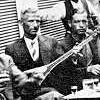|
|
The rebetika songs are an urban popular genre, merging
Greek and Turkish elements, which attained its "classical"
form in Piraeus during the 1930s (Holst 1975: 27). The origins
of the rebetika are complex. At the
end of the nineteenth century, large Greek communities lived in
the urban centers of Asia Minor, in particular Costantinople and
Smyrna(6), and many Aegean islands under Turkish domination.
These communities practised musical popular genres (examples may be found in the article by Karl Signell in this number of EOL) which may be considered precursors to the rebetika, for merging Greek music with elements (for instance, some instruments and dances, vocal style, forms of melodic decoration as well as instrumental improvisation, etc.) related to other (Turkish, but also gypsy) musical traditions. One of the most well-known forms of these popular genres is the amané, originated in Ionia and famous in Smyrna, which includes an instrumental introduction, two lines sung with long melismas on the word aman, and a faster instrumental refrain. This vocal form was practiced in the "Café-aman," a type of musical café which quickly spread in Eastern Mediterranean towns, including Athens and Piraeus, Larissa, and Thessalonika in mainland Greece. |

baglamás |
An important source of the rebetika consists also of the
underground and jail songs, from which the "mainland rebetika"
(Torp 1991: 373) arose. In prisons, a typical rebetic instrument
was born, the baglamás, a scaled-down version of
the bouzouki, that could be easily concealed. The
bouzouki and baglamás later became
the most typical instruments of the rebetika. Another place of the musical life of the underground was the tekés (pl.: tekédes), a small shop where hashish was smoked. "The music performed in these tekés was, by the turn of the century, already a form of rebetika music. Baglamás and bouzouki were becoming standard instruments and the themes of the songs were those of jail, the underworld and hashish" (Holst 1975: 24). |
|
Audio R1:taksimi for verse below |
An important
element of the rebetika were the taximia (singular:
taximi; from Turkish taksim), improvised instrumental
introductions, familiar to Turkish music, which set the mode (dromos,
pl., dromoi) of the song as heard in Audio R1(see
Dietrich 1987, 1:110-162). The dromoi were many (e.g.
minoré (audio example in Signell's article), rasti, houzam, ousak,
niaventi, etc.) and often borrowed their names from the
Turkish makam system (see Signell 1986; and Signell in press). The texts of the songs deal with the everyday life of the rebetes (hashish, prison, poverty), as in Audio R2, and often with unrequited love. |
|
Audio R2: First line of text. Stelios Kiromitis and Stratos Paghiumtsís, voices |
Complete text of one verse
Paízei to baglamadáki / kai chorévo zebekáki Songs were often accompanied by men's solo dances, for example, the large group of rebetic dances called zeïbeikos. These dances were typically performed in a tense and restricted manner with sudden releases of energy. The improvisations consisted of turns around the body axis, squats, leaps in the air, to mention a few (Torp 1991: 375). In the years from the end of the nineteenth century up until 1922, the first forms of the rebetika and their social context began appearing. In building their musical repertory, people on the fringe of the society, named koutsavakides (literally: braggarts), manges (literally: petty criminals) and later rebetes (same meaning as manges), chose a strongly syncretistic language, when, at the same time, Greek official culture was seeking in oral tradition the traces of a more prestigious continuity with ancient Greek civilization and resistance against Turkish rule (Herzfeld 1982).
The choices of rebetes were in contrast also with the attitude
of the established Greek urban society, "oriented towards
European standards and fashions", by which "the existence
of any Middle East, and in particular Turkish, influences in Greek
culture were totally neglected or strongly frowned upon"
(Torp 1991: 371). |

A group of rebetes and refugees in Piraeus, 1937 |
The event which most influenced the spread of the rebetika
was the 1922 exchange of population between Greece and Turkey,
at the end of the Greek-Turkish war. This led to a diaspora of
over a million "Greek" people (for the most part quite
used to Turkish language, Turkish culture, and Turkish way of
life) to Greek towns, in particular Athens and Piraeus. A great
part of the refugees were going to swell the underworld in cities.
Among them many were musicians, bringing with them the musical
style of Smyrna and Constantinople. The musical styles of mainland
rebetes and of refugee musicians intermingled and affected each
other, and their audiences grew. Ten years after the refugees' arrival, the rebetika had spread beyond the tekédes to become popular urban music. It the 1930s the rebetika enjoyed great popularity. Greek and U.S. recording companies began issuing rebetika songs (see Spottswood 1990 and Dietrich 1987, 1: 13-21; 197-198 for discography). The bouzoukia of the Pireotiki Compania made their mark on the recording scene, while the stage instruments of the Asia Minor little orchestras (which could include violin, sandouri, outi, kanonaki, etc.) disappeared. |
|
Sotiria Bellou, the "star" of the 1940-1950s, sings Glenda min argoporeis, a song by Vassilis Tsitsanis, the main composer of rebetika songs in those years |
However, in this period the rebetika lost some typical aspects. In 1936, Prime Minister Metaxás prohibited the recording of songs referring to hashish and underworld (see Pettan's article for similar Croatian examples of political restrictions on folk music.), so the theme of love loss prevailed. Taximia were cut or shortened, since they hardly could be included in a standard 78rpm recording lasting three minutes.The "classical" period ended when World War II broke out. The rebetika recovered vitality in the years 1946-52, enjoying an "Indian summer" (Holst 1975: 53), and revived later in connection with political protest against the colonels' dictatorship. "In the last decade, rebetika has been to some extent revived as an earthy, bluesy alternative to commercial bouzouki music" (Manuel 1988: 134). |